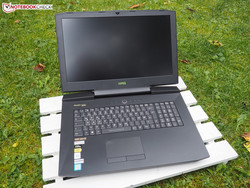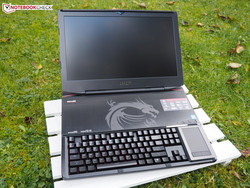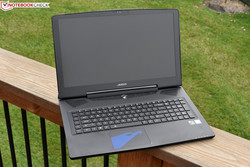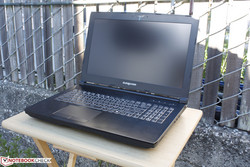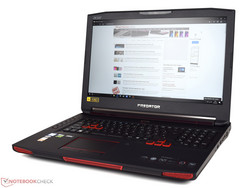The fastest notebooks of 2017
Changelog
- 07/09/2017 10:45 AM: Added GX800VH Prototype to Firestrike standard benchmarks
Every year, manufacturers release hundreds of new laptops onto the market. Entry-level options come with Intel Atom, Celeron, Pentium, Core-Y (e.g. i5-7Y54), or AMD Bristol Ridge processors and are designed as a second computer or for a casual home user who is only browsing the internet and watching Netflix. The mid-range come with Intel Core U-series processors, which are power efficient dual-core variants of the i3, i5, and i7 such as the i5-7200U. These power most ultrabooks and budget gaming laptops paired with graphics cards such as the MX150. The more powerful notebooks usually come with an H-series quad-core, such as the i7-7700HQ and are paired with very capable graphics cards like the GTX 1060. Here you find attractive gaming offerings from Clevo resellers (Sager, XMG, Eurocom etc.), MSI, Aorus, Razer and more.
But for those willing to pay, there is another category of super-powerful notebooks. These laptops often come with an overclockable processor (such as the i7-7820HK) or even a high-TDP desktop CPU (like the i7-7700K) for the absolute fastest laptop CPU performance available. These dominate games with GTX 1070, GTX 1080, or even dual GTX 1080 SLI graphics cards crammed inside. As a laptop specialist website, we test around 400 laptops every year. Our benchmark and calibration tests take multiple days to run to capture the level of detail that we aim for, but from this, we have an extensive database to dig through when comparing laptops and assessing where they fit in the notebook ecosystem. Below are our picks of the fastest laptops we’ve tested in the past year.
Fastest CPU: Cinebench R15 single-core and multi-core
Cinebench R15 is a great tool to measure the brute force power of a processor, and it has the bonus of scaling well when measuring multi-core performance. The Schenker XMG U727 2017 powered through our Cinebench tests in first place for both single-thread (193) and multi-thread (958) scenarios. Its little brother, the 15-inch Schenker XMG U507 2017, came in second place with a single-thread score of 192 and multi-thread at 919; with scores like that it is unsurprising that it uses the same desktop i7-7700K CPU.
The third-place spot alternated between two models for single-core and multi-core: The Eurocom Tornado F5 with its desktop i7-7700K Intel Core i7-7700K Desktop Processorwas slightly ahead when using a single core (190 vs. 184), while the mobile i7-7820HK in the Asus G701VIK-BA049T managed to squeak ahead when utilizing multiple cores (899 vs. 897). Finally, the Acer Predator 17 X GX-792-76DL tied for forth place in single core (184), but we placed it in fifth place since it was clearly behind in the multi-core score at 874 points.
Schenker XMG U727 2017
Click here for the full review.
There is little surprise that the XMG U727 2017 came in at first place on a CPU bound benchmark; unlike mainstream laptops with soldered BGA chips, it uses socket 1151, which enabled our unit to utilize a desktop i7-7700K processor. With a 91 W TDP, the i7-7700K able to turbo-boost up to 4.5 GHz. Socketed CPUs like this can also be upgraded if the next generation supports the same socket, extending the lifetime of the laptop.
Schenker has paired this CPU with a laptop GTX 1080, the most powerful laptop-class GPU available at the time of writing, which reaches a turbo close to 1660 MHz in this chassis (the official turbo range is 1582 to 1771 MHz). During gaming, the GTX 1080 was able to keep the FPS above the 60 Hz refresh rate on most titles at 1080p Ultra settings, and when the resolution was increased to 4K, it still kept most of the tested games between 40 and 60 fps.
Finally, it is paired with a Samsung SM961 M.2 PCI-e SSD which reported blazingly fast speeds with sequential read and write of 2746/1445 MB/s.
Fortunately, while the CPU and GPU do both get very hot, the CPU showed no signs of throttling in a 30-minute Cinebench R15 multi-core loop, and the GPU was able to maintain a level of turbo during benchmarking. However, when we ran Prime95 and Furmark at the same time there was some throttling, particularly the graphics card, although this load is unrealistic.
Price comparison
Fastest GPU: 3DMark Firestike
Fire Strike is one of the most popular 3D performance benchmarks, and this means there is a vast collection of results that consumers can browse before purchasing. It is a highly detailed benchmark designed for high-performance gaming PCs and runs at 1080p resolution.
This benchmark is dominated by SLI based notebooks, because what’s stronger than one video card? Two video cards. In first position, we have the MSI GT83VR 7RF-206 Titan SLI, whose two GTX 1080s achieved a total score of 22192. This result was followed by two more SLI setups in the Schenker XMG U727 (Skylake) with dual GTX 1080s and the MSI GT83VR-6RE32SR451, a slightly older version of our first-place winner but equipped with two GTX 1070s, which score 21423 and 21132 respectively. That last one is a particularly strong showing considering they are GTX 1070s vs. GTX 1080s.
The final two spots are filled by a couple of single GTX 1080 configurations in the Asus G701VIK-BA049T (17700) and the Acer Predator 17 X GX-792-76DL (17463). Only one of the top five in this benchmark was equipped with a desktop processor; this is likely due to the lower mobile TDP allowing a higher thermal head room for the GPUs than they would have with a desktop CPU.
| 3DMark - 1920x1080 Fire Strike Score | |
| MSI GT83VR 7RF-206 Titan SLI | |
| Asus GX800VH Prototype | |
| Schenker XMG U727 | |
| MSI GT83VR-6RE32SR451 | |
| Asus G701VIK-BA049T | |
| Acer Predator 17 X GX-792-76DL | |
MSI GT83VR 7RF-206 Titan SLI
Click here for the full review.
The answer to why this notebook is in first place at 22192 lies in the name. It is indeed a Titan, and MSI has packed inside two laptop GTX 1080 running in SLI configuration. Looking through our benchmarks, we can see that the fastest SLI system is roughly 25% faster than the highest placed single card, which is the GTX 1080 in the Asus G701VIK at 17700.
You may note that coming in close second there is also a prototype of Asus listed — the water-cooled GX800VH. A prototype at the time, the GX800 is now commercially available. We should be getting a production unit in for testing soon, and we will update the article according to the results.
To pack this graphical power into the GT83VR, MSI did have to compromise slightly. The i7-7920HQ CPU is still the fastest stock-speed mobile processor around, but it has a much lower TDP than a desktop i7. It doesn't score as highly on CPU benchmarks as desktop processors with higher boost clocks.
For storage, MSI has used a pair of Toshiba NVMe drives with sequential read/write speeds tested at a blazing fast 3045 MB/s and 2149 MB/s respectively. Memory is also present in titanic proportions with a total of 64 GB DDR4-2400 installed.
We weren't able to detect any throttling on the CPU, but one of the graphics cards did slow to 1400 MHz from an original speed of 1557 MHz.
Price comparison
Fastest GPU: 3DMark Fire Strike Extreme
Fire Strike Extreme is a good candidate for finding the laptop with the fastest 3D performance because it was specifically designed to test high-end graphics cards and SLI/Crossfire setups. It features more detailed scenes than the standard Fire Strike test and increases the resolution from 1080p to 1440p. Our laptop results are spread across Fire Strike and Fire Strike Extreme, and while most models appear in both lists, some only appear in one. Therefore, we must assess both benchmark versions in this article.
None of our SLI models appear in the Extreme list, so we see the single-GTX 1080-equipped Aorus X7 DT v6 in first place at 9557 points. All four models that follow are also using a single GTX 1080, and similar to the standard Fire Strike test only one system uses a desktop processor. In second place is the Acer Predator 17 X GX-792-76DL (9502 points), followed by the Eurocom Sky X7E2 (9473 points), Alienware 17 R4 (9422 points), and MSI GT73VR 6RF (9042 points).
| 3DMark - Fire Strike Extreme Score | |
| Aorus X7 DT v6 | |
| Acer Predator 17 X GX-792-76DL | |
| Eurocom Sky X7E2 | |
| Alienware 17 R4 | |
| MSI GT73VR 6RF | |
Aorus X7 DT v6
Click here for the full review.
The slightly older Aorus X7 DT v6 just barely slipped passed the Acer Predator 17 X in Fire Strike Extreme with a score of 9557 vs. 9502, giving a difference of only 0.58 percent. In fact, the two laptops are very similar in specification and so we could technically consider this a tie between the two. Deciding which is the better unit for you is going to come down to other factors such as screen quality, keyboard, price, or whether you would prefer a newer Kaby Lake CPU.
The Predator has the more modern CPU (i7-7820HK 2.9/3.9 GHz vs i7-6820HK 2.7/3.6 GHz ) giving it a clock speed advantage of 200 MHz (7.4 %) at base multipliers and 300 MHz (8.3 %) when utilizing a single core, helping slightly in CPU-reliant tasks. Fortunately for the X7 DT v6, the Skylake processor it is equipped with is powerful enough to keep the GTX 1080 fed even during Fire Strike Extreme.
The Samsung SM951 NVMe in the Aorus X7 DT v6 is a fast drive, but the sequential read and write speeds (1829 MB/s and 1588 MB/s) do lag behind the newer drives available inside the more recent Kaby Lake units we’ve tested.
Regarding thermals, during a CPU-only stress test, the Aorus showed a decrease from our four-core overclock of around 3.8 GHz down to around 3.3/3.4 GHz after about 45 seconds, which means that our overclock was able to avoid throttling below the default boost speed. Despite being thicker, the predator 17 X got much hotter but still managed to maintain a 3.3 GHz clock speed. The GPU in the Aorus managed a boost clock of 1620 MHz to 1650 MHz when we applied overclocking power delivery levels.
Price comparison
Fastest component mix: PCMark8 Work Score V2
The PCMark8 Work Score V2 might seem like an odd inclusion in a rundown of the fastest laptops, as it isn't anywhere near as taxing as Cinebench or 3DMark. However, it does a good job of measuring the entire system's ability (it involves RAM and storage too) when performing productivity tasks, such as using spreadsheets and browsing websites without involving any 3D based tests.
There is a noticeable drop in score between the first-placed Eurocom Tornado F5 (6515), through the Acer Predator 17 X GX-792-76DL (6123), Asus 701VIK-BA049T (5846), Asus G752VS-XB78K (5778), and finally the fifth placed Schenker XMG U507 2017 (5629). While faster processors help, it is interesting that the third, fourth, and fifth ranked notebooks are running mobile i7-7820HK or i7-6820HK processors, rather than the trend we see towards desktop models dominating the pure CPU benchmarks.
RAM and Storage are high points for models in this test. For memory, two have 64 GB, two have 32 GB, and only one is equipped with a more standard 16 GB. All models feature SSDs with blazing-fast read and write speeds with the slowest (Toshiba THNSN5512GPU7) still giving sequential read/write results of 1494 MB/s and 1371 MB/s and the fastest (Samsung 960 Pro) giving 2819 MB/s and 2046 MB/s.
| PCMark 8 - Work Score Accelerated v2 | |
| Eurocom Tornado F5 | |
| Acer Predator 17 X GX-792-76DL | |
| Asus G701VIK-BA049T | |
| Asus G752VS-XB78K | |
| Schenker XMG U507 2017 | |
Eurocom Tornado F5
Click here for the full review.
The first placed Tornado F5 has an Intel i7-7700K beating at its heart. Boosting up to 4.5 GHz at times allows it to fly through office tasks, but there are other aspects of this notebook that enable it to take first place such as the speedy NVMe drive and gargantuan amounts of high performance RAM.
Eurocom has equipped this laptop with a 512 GB Samsung 960 Pro NVMe m.2 SSD, which compares favorably against most other options that we’ve tested with read and write speeds of 2819 MB/s and 2046 MB/s respectively. This result makes it the fastest SSD installed in the top five laptops in this comparison, and one of the most rapid on our SSD comparison tables. The 64 GB of RAM is both unusual in the sheer capacity that it is present in, and also in the speed; The DDR4-3200 continues the trend of the Tornado F5 having the fastest components in this comparison.
The CPU does throttle during Prime95, alternating clock frequency between 2.4 GHz and 4.3 GHz. However, when running a more variable load like Unigine Valley, then both CPU and GPU maintained consistent boost levels.
Price comparison
Most Balanced
While digging through our benchmark database for this article, we noticed that some notebooks would excel in a single area, while others were more balanced and would score more evenly across the board. The eagle-eyed among you may have already noticed that when it comes to the top five, there is only one laptop that appeared on all four charts: The Acer Predator 17 X GX-792-76DL.
Acer Predator 17 X GX-792-76DL
Click here for full review.
In CPU based Cinebench testing the Predator 17 X was in a fourth place tie for single core performance (184) and fifth place for multi-core (874). This result is quite impressive given that it has a mobile processor, as many of those placed around it in benchmarks have desktop-class processors with higher TDPs and higher boost speeds. Although not a desktop-class CPU, the i7-7820HK has the honor of being one of the few overclocking-capable mobile processors, which means that when adequately cooled a few hundred extra MHz can be squeezed out.
A score of 17463 in Fire Strike and 9502 in Fire Strike Extreme were good enough for fifth place and second place respectively. It took a trio of laptops with dual GPUs in SLI configuration to push the single-GTX 1080 Predator 17 X down the charts.
For PCMark8 Work V2, the Predator 17 X comes in second place with 6123 points. Interestingly, this model had the lowest capacity of RAM in the benchmark at 16 GB DDR4-2400 and the slowest NVMe SSD sequential read and write at 1494 MB/s and 1371 MB/s, perhaps the good 4 K speeds were the redeeming quality for this drive.
When overclocked to 4.3 GHz and running a Prime 95 benchmark, the CPU does trip the thermal-throttle flag. However, even with the toasty hot temperatures, it was still able to maintain a four-core clock speed of 3.7 GHz average, significantly above the base four-core speeds. At stock settings there is no CPU throttling, but the four cores run at an average of 200 MHz slower than when overclocked. When running a combined stress load on both CPU and GPU, the GPU will maintain its rated speed, but the CPU will drop even further to 3.3 GHz.
Price comparison
Conclusion
With hundreds of laptops released every year, finding the right one for your needs can be an arduous and confusing task. We have gone through the results of the roughly 400 laptops we've tested in the last 12 months and presented our picks in each category. Graphics card and storage technology was fairly uniform over the various categories, but it was fascinating to see how well modern mobile processors perform compared to their desktop counterparts, even at half the TDP rating. Every year the trade-off between desktops and laptops is less about performance and more about the price premium required to go to a compact form-factor.
If your use case involves CPU heavy tasks, such as video encoding, then you will likely be best suited to an i7-7700K equipped model such as the Schenker XMG U727 2017 or the smaller Schenker XMG U507 2017. These large, chunky laptops get hot, but they only showed signs of thermal throttling when put under the unrealistic scenario of running both Prime95 and Furmark at the same time.
When hardcore gaming is on the cards a dual GTX 1080 SLI laptop like the MSI GT83VR 7RF-206 Titan SLI should be near the top of your list. If 18-inches is too large, then the 17-inch Schenker XMG U727 (Skylake) is worth considering. SLI configurations still sometimes have issues with smooth operation, so it isn’t unusual to need to perform a bit of troubleshooting with a new game. While not providing as much raw performance, setups with a single GTX 1080 are less hassle, and the Aorus X7 DT v6 is relatively slim and one of the more portable options — if you can call a 17-inch powerhouse ‘portable.’ The Kaby-Lake-equipped Acer Predator 17 X GX-792-76DL scored almost identically and is an excellent choice for those who want to avoid buying something with older generation components inside.
Many productivity tasks will benefit from speedy NVMe storage drives and mountains of RAM. Workflow that includes locally stored database programs or running macro-heavy spreadsheets will process flawlessly on the Eurocom Tornado F5 with a Samsung 960 NVMe and a gargantuan 64 GB DDR4-3200 RAM. We do need to point out that these are the most easily upgradable parts of a notebook, therefore if another laptop fits your needs but has slower storage or less RAM then don’t just ignore it.
Finally, most of us don’t just use our laptops for a singular task. They are our trusty workhorses that edit photos, encode videos, crunch numbers, and at the end of the day they play games. In these situations, a well-balanced system is often more advantageous than one that excels in a single area. The Acer Predator 17 X GX-792-76DL was the only model which appeared in the top five across all categories, and the overclockable i7-7820HK, GTX 1080, 16 GB RAM, and Toshiba NVMe drive make it a top pick.





